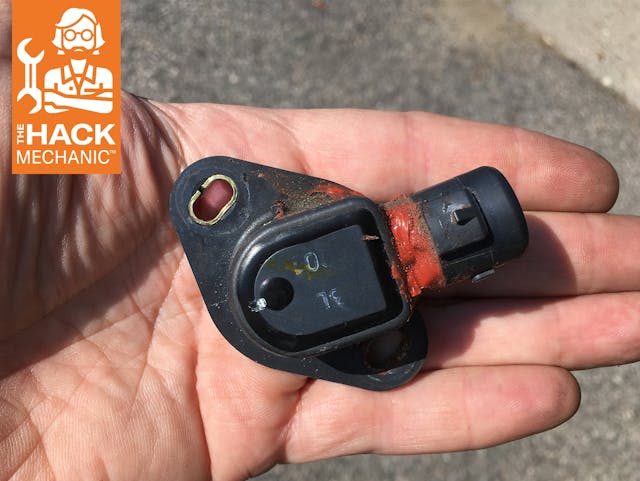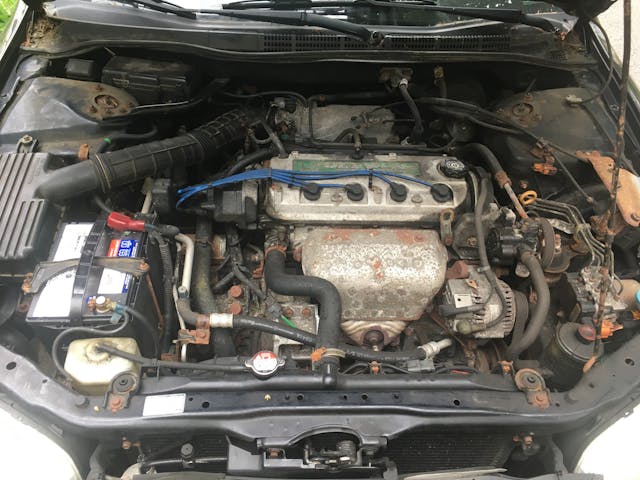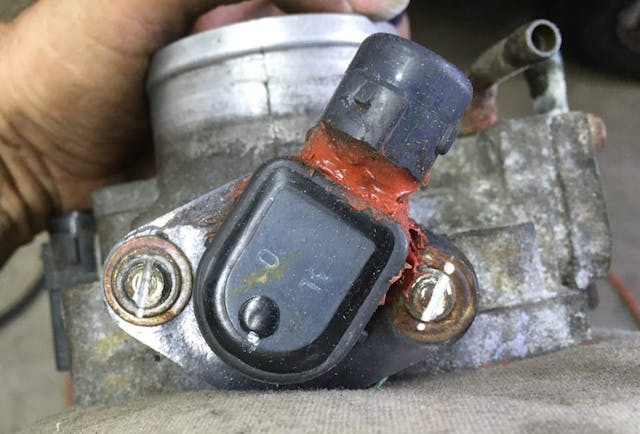Here’s why working on a family member’s car can be dicey

My first book includes five chapters under the section title, “Why I Don’t Fix Cars For Other People, Part XXX.” It’s something of a running joke, since, in each, I describe doing a favor for someone only to have the repair go wrong, cost them more money than either of us expected, and leave me with the feeling that no good deed goes unpunished. The fact that I give five examples shows that either I’m a ridiculously good guy or I’m someone who’s really slow to learn a lesson.
Of course, it doesn’t always end badly. Decades ago, my sister-in-law totaled her Toyota Tercel, and I found her one with a good body and a dead engine and swapped engines for her, something which won me no small amount of respect from my father-in-law, even though he was a dyed-in-the-wool Chevy guy. And I suppose the time I put an engine into my friend Alex’s Passat work out OK, but he built the garage I did the work in and we have a 35-year history of doing each other favors, as good friends do.
And there was the time, just a couple of months ago, when my neighbor/friend who now owns my BMW Z3 reported that it wouldn’t rev above 3000 rpm and that the check engine light was on. This clearly was the electronic throttle being stuck. There’s no cable between the accelerator pedal and the throttle body; instead the pedal sends a signal to a motor that opens the throttle. So you can mash the pedal, it’ll squirt in fuel, but the throttle plate won’t open to let air in. In an hour and a half, I had the throttle body cleaned (I also cleaned the idle control valve while I was in there) and everything put back together. Problem solved, neighbor/friend grateful, she cooked me and my wife a socially-distanced dinner, everybody won.
But in general, that feeling of control, completion, and Zen I get working on my own cars flies out the window when I tackle someone else’s project. Even if it’s a favor and no money changes hands (so there’s no strict liability issues), things go wrong, their problem has become your problem, and under the best of circumstances you still have someone else’s car taking up your time, real estate, mental bandwidth, and stress allocation.
Fixing cars for family members is perhaps the thorniest. I have a great family, so I want to help them, and they almost never ask because they don’t want to bother me. That’s how it should be. But when the call comes, you do feel obligated.
With that as backdrop, my youngest son, Aaron, called me saying that he was having a problem with his 2001 Honda Accord. He’s a great kid, he listens, he’s takes my advice, and he’s not afraid to get his hands into things. He works a few miles from where I live, so I told him to swing it by. A few weeks earlier he’d told me that the car was having what appeared to be battery issues (weak cranking), so I thought this was that, but when he arrived at the house with the car, he explained that he’d replaced the battery, and the car still had occasional no-start issues, and sometimes even died while driving.
I should first explain about the condition of this car. My editor here at Hagerty won’t let me swear in print, so I’ll say that the Honda is a car you’d refer to with a two-syllable word where the first part rhymes with “Brit” and the second part is “box.” He got it from a high school friend’s parents in exchange painting a bedroom. It has lived in New England its entire life. It’s tickling 200,000 miles. It’s black with peeling clear coat. There are dents and rust in every body panel. And the engine compartment looks like it’ll give you either leprosy or cooties if you touch it. He actually has a nicer car now (he inherited my mother’s lightly-used 2007 Corolla when she passed last summer), but he keeps the Honda because his girlfriend uses it. As I said, he’s a great kid.


I test-drove the car around the block. Apart from questionable shocks/struts and an obvious swishing sound from a dust shield touching one of the front rotors, it seemed to run fine. I pulled it back into the driveway and began to explain to Aaron that there wasn’t much I could do unless it exhibited the problem. As if on cue, a minute later the idle dropped and it sputtered and died. I tried to restart it and it cranked but didn’t catch. I thought “Great that it’s exhibiting the problem, but now I have a dead car in my driveway blocking everything else in the garage.”
The adage that a car needs gas and spark to run is true (more accurately: gas, spark, air, correctly-timed ignition, compression, and a few other things), but the newer the car, the more that sensors and computers are involved in enabling the gas and spark, making troubleshooting challenging. I hooked up an OBD-II code reader, but there were no stored codes. This car is old enough that it still has exposed plug wires, so I pulled one off, stuck a screwdriver in the wire boot, and held the shank a quarter inch from ground while Aaron cranked the starter over. Initially I didn’t think I saw anything, but then the car started and idled on the three connected cylinders. Very odd.
I let it idle for a few minutes, then revved it up to about 3000 rpm and let the throttle snap closed. It immediately died. I restarted it, did it again, and the same thing happened. I repeated this four or five times. At least the failure was being consistent. I went to the laptop in the garage and Googled “2001 Accord stalls after revving,” and found a series of posts that implicated a carboned-up Idle Air Control Valve (IACV) and possibly the throttle body—yes, coincidentally, just like my former Z3, although this car has a cable throttle. I told Aaron that I’d be happy to pull these components and clean them, but that he’d have to leave the car. I drove him home.
In the morning, I had at the ratty Honda. I pulled one of my Hagerty-insured cars out of the garage and pulled the Honda in so I could work in the shade. I yanked off the intake boot and looked in the throttle body. There was a light coating of carbon, but nothing horrible. I cleaned it with carb cleaner and a toothbrush.
Next was the idle air control valve. IACVs are used on most fuel-injected cars as a way to allow extra air into the intake manifold during cold start and warm-up. They typically have a little electrically operated solenoid that rotates a valve between two or three positions. The valve is usually free to rotate until a current is applied to the solenoid, so a way to test them is to remove them and twist/shake them, and then see if you can hear the valve sounding almost like the rattle in a paint can.
Unfortunately, this one was an absolute bear to access and remove. It’s bolted to the back of the intake manifold, and with the transverse-mounted engine, that means it’s squeezed between the manifold and the firewall.

I pulled off the connector to the IACV, and another one to the Throttle Position Sensor that was in the way, and I could fit a 10-mm wrench back there to undo the two bolts holding it in place. But there were three connections on the bottom—one vacuum line and two coolant hoses—that could only be accessed once the valve was pulled partially out. One of the hoses was too short to pull it where it needed to be, and it was held in place with one of those awful little sprung clamps with tabs you needed to squeeze with pliers to release it, and reaching the tabs was almost impossible. It took me nearly an hour just to remove the hose.

In the middle of all this, with repetitive leaning in, drawing myself out, grabbing another tool, and bending back over, I got careless and let the front right corner of the hood catch my forehead. It opened up a small gash—not large enough to stop and bandage it, but big enough to augment my dislike of the car. Sort of like a good wine pairing. Pinot Noir with red meat seemed particularly appropriate.
Finally, I got the IACV assembly out. The valve was visibly carbon-contaminated and did not appear completely free to move. I cleaned it with carb cleaner, then tested it with 12 volts. I’ve always treated IACVs by assuming that if the connector has two terminals, the valve has two positions (open and closed), and solenoids are just little electromagnets that don’t care which terminal is 12V and which is ground, and that if there are three terminals, the valve has three positions (rotate left, neutral, rotate right), and thus you can figure out which terminal is ground and which cause the valve to move by trial and error. But my inner lawyer advises you that it’s lower risk to consult a wiring diagram or a pin-out for the connector. After cleaning, I tested the three-position valve, and it moved correctly.
I then reinstalled the valve, which was almost as bad as taking it out. The reconnection and re-clamping of one of the coolant hoses with its little spring clamp was again absolutely maddening. I resolved that if for some reason I needed to do it again, I’d lengthen the hose.
But while I was reconnecting the Throttle Position Sensor (TPS)—the little resistance-track device that is rotated by the throttle shaft and directly measures how far the throttle is open—I noticed that the base of the connector housing on it appeared oddly discolored. Worse, as I put the plug into it, I felt the housing move. As I pushed on it, I realized that the housing was cracked, and wondered whether this, in fact, was the source of the problem and not the IACV.
I reassembled everything, started the car, and the Check Engine light immediately came on. I connected my OBD-II code reader, and it read a P0122 code, with the description “TPS/pedal position sensor circuit low input.” I revved the car up and let the throttle snap shut, and it didn’t stall. But when I took the car for a very short test drive, it cyclically revved and then completely lost power in roughly five-second intervals. I again cleared the code, started the engine again, and the TPS code immediately reappeared. My conjecture was that, by pushing on the cracked TPS housing, I’d taken something that had been intermittent and made it fail.
Gotcha.

So I needed a TPS. I wanted to be certain I got the right one, and that meant first pulling out the old one. I tried to unbolt it from the throttle body, but like the IACV, the fasteners were facing the firewall, and I couldn’t tell what fasteners they were, even using a mirror. I tried Phillips bits, Allen keys, even little Torx bits, and nothing slid in. I looked online, and to my chagrin learned that the original TPS is installed with one-time break-off fasteners into which slots need to be cut to remove them. This meant pulling off the throttle body, and that meant leaving the car disabled in my garage. There didn’t seem to be much choice though. After all, if I couldn’t get the TPS off the throttle body, I’d be shopping for a whole used throttle body.

Holding the throttle body in my hand, I could see that the “discoloration” I was seeing on the TPS was actually old red RTV that had been applied to the housing, and that the crack on the back side of the connector was yawning open. I cut slots in the foolish fasteners with my Dremel tool and removed the TPS.

When you’re working on an enthusiast car and need parts, unless you’re frantically readying it for a road trip, you typically don’t need it running by morning and thus can usually shop online for the best price and wait for the parts to arrive. On a car you or someone else needs back quickly however, the dynamic gets flipped on its head, and you’re willing to drop everything, drive to a dealership, and pay almost whatever is necessary to get your hands on a part right now. In this case, the timeframe wasn’t dictated so much by the need for the car but rather by the weather; the report was for four days of intermittent thunderstorms, and I really hated to have any of my rust-prone vintage cars sit outside and have this disabled you-know-what-box occupy a coveted indoor space.
So I called a local Honda dealer. They quoted me a jaw-dropping $243 for the TPS. They didn’t have it in stock anyway, so the nosebleed-level price was simply funny.
I checked on Amazon, and they had the Dorman-manufactured part for $29 with two-day shipping. I hated the idea of one of my BMW 2002s sitting outside in the rain for two days, but I didn’t seem to have much choice. I nearly clicked and bought the part, but then I realized I had one other alternative.
There aren’t nearly as many local auto part stores as there used to be—places like Autozone are OK for batteries and wiper blades and maybe brake pads for a Suburban, but they’re not great for parts like this—but there is an Autopart International (also known as Foreign Autopart) about two miles from my house. The outfit mainly serves independent garages, but it also sells parts over the counter. I called, and they said they didn’t have the TPS, but their warehouse in Marlborough did. I called and asked them to pull the part off the shelf to verify its existence and hold it for me. For $59 and a half-hour drive, I had the part in my hand. I laughed when I opened the box and found that it was the exact Dorman part that Amazon charged $29 for. Still, it was totally worth the extra 30 bucks to have the project buttoned up and get my garage back before the rain. It even came with Allen-head screws to replace the break-off fasteners.

The instructions that came with the TPS were to install it, then back-probe the connector on pins 2 and 3 and adjust it by rotating it so the voltage reads 0.5V at closed throttle and 4.5V at wide-open throttle. It took me a while to find my back-probe pins, as I hadn’t used them in a while. I never could get it exact—its range seemed to be about a tenth of a volt short—but I split the difference between the two extremes and tightened up the Allen-head fasteners.

I cleared the codes and started the car. The Check Engine light remained out. I drove the car around the block. No light, no codes. I revved it in my driveway as I’d done the previous day and experienced no stalling.
Prior to finding the cracked TPS housing, I wasn’t certain that I’d really done anything that might prevent the car from dying again, but by finding the damage, making it worse, replacing the part, and having the problem and the codes go away, I could somewhat confidently say that I’d actually found and fixed something.
Before I reclaimed my garage bay, I jacked up the front of the car and pulled the rusty dust shield away from the rotor, eliminating the scraping sound.
My son Aaron now has his car back (I should say, “My son Aaron’s girlfriend has his car back”) and I emerge, victorious, the father-hunter-mechanic, only slightly bloodied from the experience.
I am a good father.
But don’t ask me to work on your car unless you’re one of my kids. Or built my garage. Or are a close friend of my wife or my sister. Or own something really cool. Or are really—really—in need. Or can tell me a great story. Or can cook my wife and me a nice dinner, something with red meat and Pinot Noir. Because, honestly, I don’t fix cars for other people.
***
Rob Siegel has been writing the column The Hack Mechanic™ for BMW CCA Roundel magazine for 34 years and is the author of five automotive books. His new book, Resurrecting Bertha: Buying back our wedding car after 26 years in storage, is available on Amazon, as are his other books, like Ran When Parked. You can order personally inscribed copies here.

